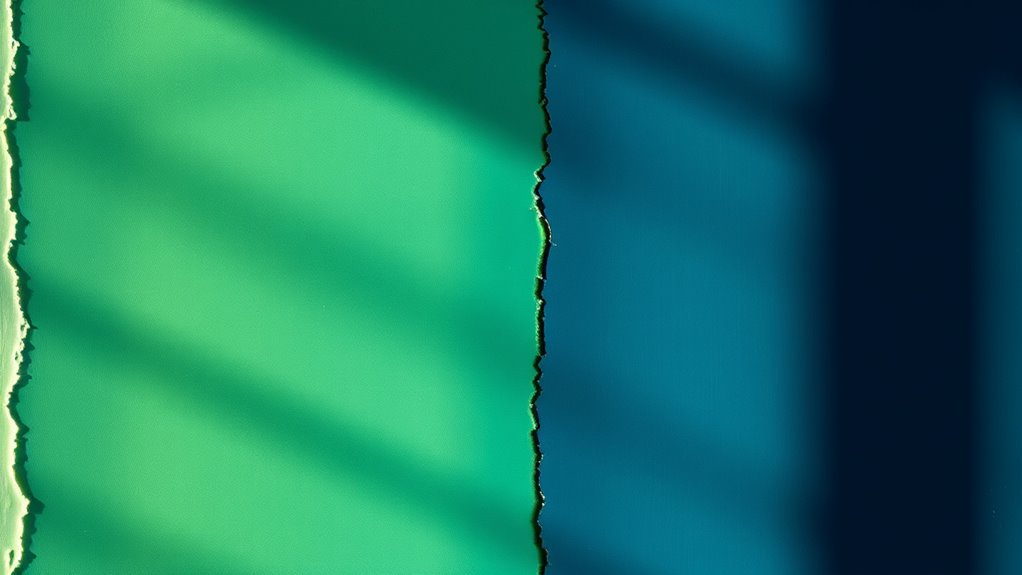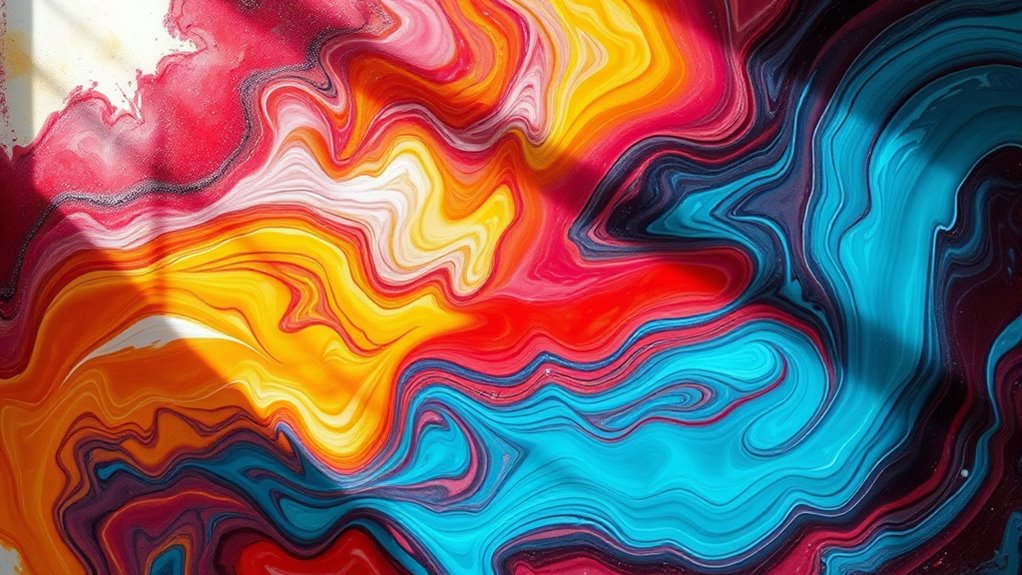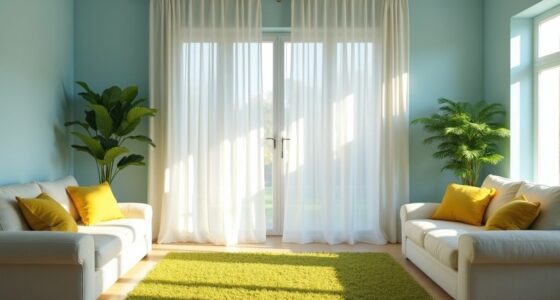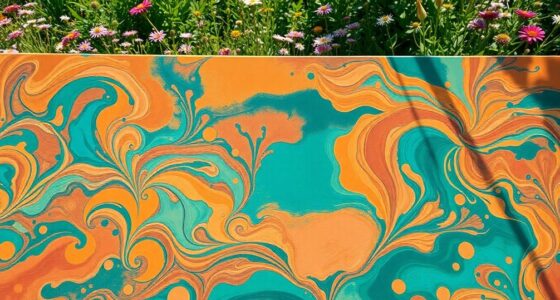Lighting plays a big role in how you see paint colors. Natural sunlight makes colors look vibrant and dynamic, highlighting undertones and changing with the time of day. Artificial lights, like warm incandescent or cool LEDs, can make colors appear softer, brighter, or duller. The type and angle of light also affect finishes, influencing the overall mood of your space. If you keep exploring, you’ll discover more ways light transforms your color choices.
Key Takeaways
- Natural sunlight enhances warm or cool undertones, making colors appear more vibrant or muted throughout the day.
- Artificial lighting, like incandescent or LED, can alter color perception by adding warm or cool hues.
- Matte finishes diffuse light, softening colors, while glossy finishes reflect light, intensifying color vibrancy.
- Lighting intensity and angle can wash out subtle shades or emphasize specific hues in painted surfaces.
- Proper lighting choices help achieve desired ambiance by complementing paint colors and finishes.

Have you ever wondered how lighting and paint colors work together to transform a space? The way a room looks can change dramatically depending on the lighting you use and the type of paint on your walls. Natural sunlight, with its dynamic and warm qualities, can make colors appear vibrant, soft, or even slightly different from how they look under artificial lighting. When sunlight streams through your windows, it highlights the undertones in your paint, emphasizing warm or cool hues and giving the space an inviting feel. But as the day progresses, the light shifts, and so does the appearance of your walls, making your room feel lively or calm depending on the time.
Artificial lighting plays an equally crucial role in how your paint colors are perceived. Incandescent bulbs, for example, emit a warm, yellowish glow that can make reds and yellows appear richer and more inviting. On the other hand, cooler LED or fluorescent lights tend to cast a bluish hue that can make blues and greens seem more subdued or crisp. When you choose your lighting fixtures, you’re essentially choosing how your paint color will be experienced. The intensity and angle of the light also matter—overhead lighting can wash out subtle shades, while lamps with adjustable brightness can help you fine-tune the room’s mood.
The interaction between lighting and paint colors isn’t just about the type of light but also how it interacts with the paint’s finish. Matte finishes tend to diffuse light, softening the color and reducing glare, which can make bold colors feel more muted. Glossy finishes reflect more light, often intensifying the color and adding a sense of brightness and vibrancy. When you combine this with the lighting choices, you can dramatically alter the atmosphere of your space. For instance, a soft, pastel hue might look serene during the day under natural sunlight but can seem more muted or even dull when lit with harsh artificial light at night.
Understanding this relationship helps you make smarter choices when selecting paint colors and lighting fixtures. If you want a room to feel warm and cozy, opt for warm paint tones and lighting that mimics natural sunlight or soft artificial bulbs. For a modern, crisp feel, cooler colors paired with bright, white artificial lighting will do the trick. Being aware of how lighting influences paint colors allows you to create a space that feels exactly how you want it—whether vibrant and energetic or calm and soothing. So next time you’re decorating, remember that lighting isn’t just about illumination; it’s a crucial tool in shaping the overall look and feel of your space. Recognizing how lighting conditions interact with paint finishes can help you achieve the desired ambiance with confidence.
Frequently Asked Questions
How Does Natural Light Differ From Artificial Light in Affecting Paint Colors?
Natural light varies throughout the day, affecting your paint colors with changing color temperature and light intensity. In bright daylight, colors appear more vibrant and true, while softer evening light makes them look warmer or duller. Artificial light, depending on its color temperature, can cast cool or warm tones that alter your paint’s appearance. You notice these differences as the light’s intensity and temperature shift, changing how colors seem in your space.
Can Lighting Changes Make Old Paint Colors Look New Again?
You can make old paint colors look new again by adjusting your lighting fixture styles. Different lighting can highlight or soften paint color psychology, giving your walls a fresh feel. Swapping out harsh or outdated fixtures for softer, more modern ones can dramatically change how the paint appears, making it feel updated and vibrant. Remember, a little change in lighting can breathe new life into your space without repainting!
What Types of Lighting Are Best for Accurately Viewing Paint Colors?
You should use LED lighting with high color rendering index (CRI) for the most accurate view of paint colors. LED lights mimic natural daylight, helping you see true shades and undertones. Look for options with a CRI of 90 or above, as they reveal colors more faithfully. This way, you can confidently choose and match paint colors, ensuring they look their best under various lighting conditions.
How Do Seasonal Daylight Variations Impact Paint Color Perception?
Seasonal daylight considerably impacts your paint perception by altering the light’s color temperature and intensity. During winter, the cooler, dimmer light can make colors appear duller or more muted, while summer’s brighter, warmer daylight enhances their vibrancy. You should view your paint samples at different times of year and under varying daylight to ensure your chosen color looks good year-round, avoiding surprises when seasons change.
Are There Specific Paint Finishes That Respond Better to Lighting Changes?
Did you know that matte finishes are more forgiving under changing lighting conditions? They absorb light, reducing glare and showcasing color variations more subtly. When choosing paint finish options, consider matte or eggshell finishes to enhance lighting and mood adaptability. These finishes respond better to lighting changes, creating a cozy, inviting atmosphere. So, if you want your walls to look great in any lighting, opt for matte or eggshell finishes for a versatile, mood-enhancing space.
Conclusion
Remember, lighting can totally transform your paint colors, making them appear different than in your mind’s eye—it’s like stepping into a real-life version of a Renaissance painting, where shadows and light dance together. So, don’t forget to test your colors under various lighting conditions before committing. Even if you had a time machine, you wouldn’t want to miss the chance to see how your space truly looks in different lights. Your perfect shade is waiting!









